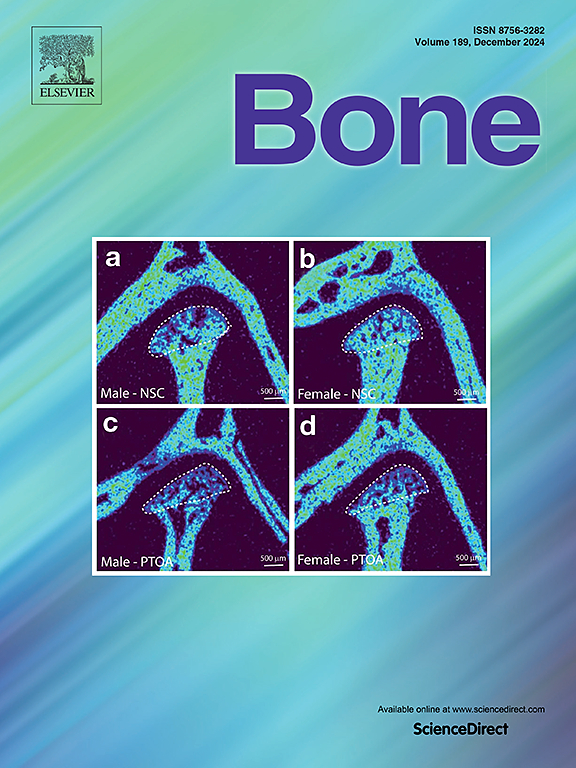Parathyroid hormone levels following denosumab vs. zoledronic acid therapy for osteoporosis
IF 3.5
2区 医学
Q2 ENDOCRINOLOGY & METABOLISM
引用次数: 0
Abstract
The objective of this retrospective, database study was to characterize the rate, magnitude and timeline of increases in parathyroid hormone (PTH) levels post-denosumab (DMAb) vs. zoledronic acid (ZA) injection in patients with osteoporosis and near normal baseline PTH. Included were osteoporotic females, 50 years, initiating treatment with 60 mg DMAb or 5 mg ZA. PTH levels within 6-months post-DMAb or 12-months post-ZA injection were extracted from the electronic database of a 4.5 million-member health maintenance organization. The indication for PTH measurements was unknown. Exclusion criteria were creatinine >2 mg/dL, vitamin D < 50 nmol/L or parathyroid hormone level > 1.5 × upper limit of normal (ULN). Among 3317 women, 1992 received DMAb and 1325 ZA. The DMAb group was older (73.3 ± 8.5 vs. 69.8 ± 8.6 years, p < 0.001) and more patients treated with DMAb compared with patients treated with ZA had prior non-vertebral fractures (7.7 % vs. 5.2 %, p < 0.01) and had previously been treated with osteoporosis medication (56.3 % vs. 50.3 %, p < 0.001). Among the patients, 14.9 % had at least one post-treatment PTH > 1.5 ULN. Of 7273 post-treatment PTH tests, 62.6 % were within normal limits, while 24.8 % were mildly elevated at 1.01–1.5 ULN. Two-months after both treatments, >1.5 ULN PTH levels peaked at ∼20 %. Elevated PTH was associated with eGFR < 60 mL/min/1.73 m2 and comorbidities. In conclusion, most PTH levels post-DMAb or ZA in osteoporotic patients with baseline PTH < 1.5 ULN, were within normal range. PTH increased to >1.5 ULN in 14.9 % of patients; peaking in the first 2-months post-treatment and declining thereafter. Elevated PTH may be related to anti-resorptive effects and is not medication specific. PTH measurements in the first few months post-DMAb and ZA therapy should be limited.
去地单抗与唑来膦酸治疗骨质疏松后甲状旁腺激素水平。
这项回顾性数据库研究的目的是描述骨质疏松症和接近正常基线PTH的患者注射地诺单抗(DMAb)与唑来膦酸(ZA)后甲状旁腺激素(PTH)水平升高的速率、幅度和时间。纳入骨质疏松症女性,≥50 岁,开始治疗时使用60 mg DMAb或5 mg ZA。从一个拥有450万会员的健康维护组织的电子数据库中提取注射dmab后6个月内或注射za后12个月内的PTH水平。甲状旁腺激素测量的适应症是未知的。排除标准为肌酐bbb2.0 mg/dL,维生素D 1.5 × 正常上限(ULN)。在3317名女性中,1992名接受了DMAb, 1325名接受了ZA。DMAb组年龄较大(73.3 ± 8.5 vs. 69.8 ± 8.6 岁,p 1.5 ULN)。7273例治疗后PTH检查中,62.6 %在正常范围内,24.8 %在1.01-1.5 ULN轻度升高。两种治疗后2个月,bbb1.5 ULN PTH水平达到峰值~ 20% %。PTH升高与eGFR 2和合并症相关。总之,骨质疏松症患者dmab或ZA后PTH水平最高,基线PTH为 1.5 的患者ULN为14.9 %;治疗后2个月达到高峰,此后逐渐下降。甲状旁腺激素升高可能与抗吸收作用有关,不是药物特异性的。dmab和ZA治疗后最初几个月的PTH测量应该受到限制。
本文章由计算机程序翻译,如有差异,请以英文原文为准。
求助全文
约1分钟内获得全文
求助全文
来源期刊

Bone
医学-内分泌学与代谢
CiteScore
8.90
自引率
4.90%
发文量
264
审稿时长
30 days
期刊介绍:
BONE is an interdisciplinary forum for the rapid publication of original articles and reviews on basic, translational, and clinical aspects of bone and mineral metabolism. The Journal also encourages submissions related to interactions of bone with other organ systems, including cartilage, endocrine, muscle, fat, neural, vascular, gastrointestinal, hematopoietic, and immune systems. Particular attention is placed on the application of experimental studies to clinical practice.
 求助内容:
求助内容: 应助结果提醒方式:
应助结果提醒方式:


